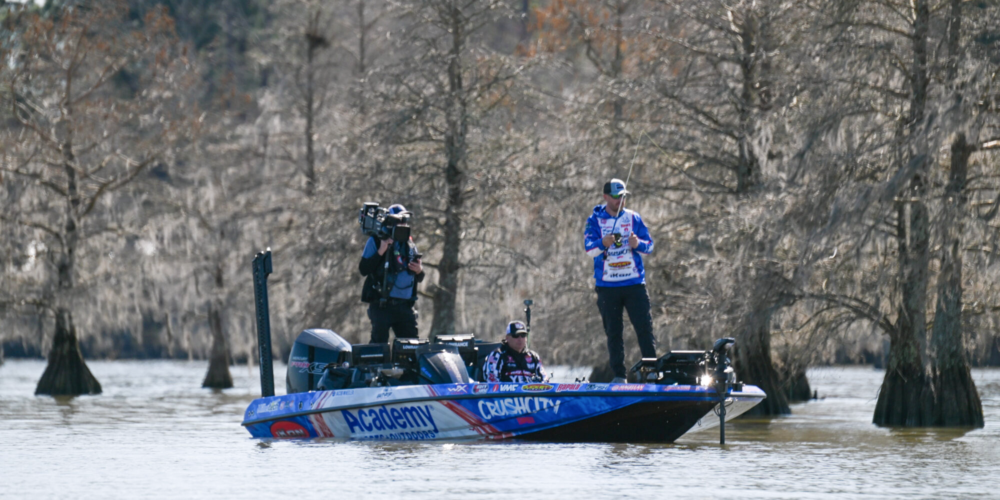Wheeler combined SideScan, forward-facing wizardry in Stage Two win at Santee Cooper
Mercury pro dialed in his winning fish with a savvy gameplan, key info from side imaging

Mercury Pro Team angler Jacob Wheeler won his seventh MLF Bass Pro Tour event last week on the Santee Cooper Lakes, which wasn’t a shock to anyone who’s paid attention to Wheeler’s death grip on the No. 1 spot in professional bass fishing. Wheeler leaned heavily on forward-facing sonar (FFS) to notch his seventh win on the BPT, another truth that probably won’t surprise you.
However, there’s more to Wheeler’s success on Santee Cooper than simply turning on his FFS and casting at fish. Wheeler’s pathway to his seventh silver-and-red BPT trophy required some old-school strategizing, extra “practice” time and some older – yet still vital – technology.
“I spent a lot of time idling, looking for rocks, brush, stumps, any kind of cover,” Wheeler said. “Granted, a lot of people were doing that. It’s no secret on Santee Cooper that bass use brush during prespawn or whenever they’re not spawning. I knew I had to do something slightly different.”
Fishing away from the crowd
Wheeler made the decision early in practice to get away from the crowds. But the community holes he spent some time around on Day 1 of his three-day practice fed him some vital pieces of information that eventually helped him win.
“I started practicing in some obvious areas and found a lot of other anglers there – I knew I couldn’t win with that many anglers around,” Wheeler admitted. “So I went a little old school and idled around looking for structure that held a few fish. I used the areas with more populations of bass to see how they’d react, but then transferred that knowledge to the areas I located away from the crowds.”
Wheeler spent the bulk of his tournament working through less-than-obvious areas on Lake Marion. By targeting secondary and tertiary locations, he was able to fish alone or with fewer anglers around, allowing him to access bass that received less fishing pressure. He spent his first qualifying day fishing around areas he’d identified in practice, racking up 53 pounds, 8 ounces on 13 fish and giving himself a comfortable cushion so that he could spend Day 2 expanding on his areas.
“I caught enough bass on the first day to turn Day 2 into a practice day for me,” Wheeler said. “On Day 2, I wanted to see if I could pull the fish off cover, but not catch them all. I knew I could catch those fish, and I knew this could set me up for success in the Knockout Round and beyond.”
SideScan proved pivotal
Older-school technology became as important to the overall victory for Wheeler as the more current FFS units.
“I can’t emphasize how important SideScan was,” Wheeler said. “I have many years of experience of knowing what to look for with SideScan. If I didn’t have side imaging, I wouldn’t have won. I would’ve done okay, but combining FFS and side imaging is such a crucial technique to be able to really zero in on the fish and cover.
“We lose the art of side imaging sometimes, but it’s still so relevant. Anglers need to realize that FFS is part of the game, but there’s a big difference between casting at dots and really understanding the cover you’re fishing.”
Wheeler relied heavily on a tried-and-true rod and reel combo and his beloved Rapala Crush City Freeloader, a bait that has quickly helped him amass hundreds of thousands of dollars in winnings in its brief existence.
“I’d say I caught 80% of my bass with the Freeloader,” Wheeler said. “I used a 1/8- and 3/16-ounce head with it. I also caught some on the Mavrick jerkbait, but fish (stopped reacting to) that as the tournament progressed. One key for fishing the Freeloader is definitely having the right rod. I use a 7-foot, medium, fast action to impart proper action for the Freeloader, to make the bait roll. It’s basically a finesse scrounger. I can make it roll, but it’s very important to manipulate the bait properly.”